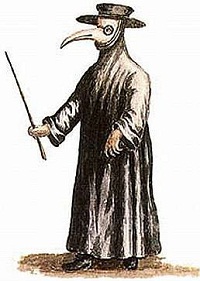
Resources
![]() Centers for Disease Control
Centers for Disease Control
![]() World Health Organization
World Health Organization
![]() WebMD
WebMD
![]() National Foundation for Infectious Diseases
National Foundation for Infectious Diseases
![]() Medscape Infectious Diseases
Medscape Infectious Diseases

Outbreak: A Webquest about Epidemics
Ring around the roses
Pocket full of posies
Ashes, ashes
We all fall down
A popular children's rhyme has darker origins. A rhyme that told a grim tale for those who had been infected with bubonic, or Black Plague. The word "roses" referred to a red rash that was often the first symptom of infection. Posies were flowers that were put in the pockets that were thought to protect you from the disease. In other interpretations, the posies covered up the horrible smell of those with the disease and all o the corpses that piled up in the streets. "Ashes"could have referred to cremated bodies or it may have originally been "a-choo" to represent sneezing. Obviously, "we all fall down" refers to the deaths of those who had been infected. In London, at the time of the outbreak in the 1600's, the death rate was over 60%.
Humans have always been under assault from pathogens. Until the development of the germ theory, and aspectic techniques, people did not understand why you got sick or how to effectively treat diseases. Epidemics could cause the breakdown of society when lawmakers, doctors, and police all fell ill. A plague could turn away armies, end wars, and cause a complete change in a government or culture. Plagues could even wipe out whole groups of people and destroy cultures.
In this webquest, you will investigate a communicable disease and publish your findings as either a powerpoint presentation, a prezio, or a website. Check with your instructor on other media that might also be acceptable.
Process
1. Choose Your Disease: Determine what disease you would like to investigate and check with your instructor. In this quest, you will only be focuses on communicable diseases, or those diseases that can be passed from person to person. (This then would exclude genetic disorders and most types of cancer and autoimmune disease). The disease list might be a good place to start if you are unsure what are acceptable topics. The publication is a group project, and ideally, no two groups will be doing the same disease.
2. Research your disease: You are going to need to find specific information about the disease. You can include more information if you like, but make sure you have the following questions answered some where in your presentation. To discourage plagiarism, copy each of the questions on a 5x7 notecard and write, by hand, your findings. Keep track of any websites of sources you have visited. You may want to do this part separately, and then reconvene with your group to compare what you have found and decide what will go into the final presentation. You will need to turn in at least 8 notecards. (Your instructor may allow you to just jot your notes on paper rather than notecards.)
a) What is the history of the disease, where was in first discovered?
b) What are the symptoms of the disease? How is it diagnosed?
c) How does a person contract the disease?
d) What is the prognosis for the patient? (How long will they remain sick, will they die, are they contagious, will there be lingering effects..)
e) How can the disease be treated or cured?
f) How can the disease be prevented? Are there vaccines or antibiotics?
g) What is the future of this disease, are we likely to every cure it? Is the disease useful in some other way?
h) Interesting facts or trivia about the disease, interesting cases or famous (infamous) people related to the disease
3. Build your presentation: Decide as a group, how you will present your topic, use the notecards as a guide for determining layout and flow of the information. Your instructor may or may not require an oral component. The following list of resources may help you decide what is the best choice for your group and topic,
Flash Site Builders - these drag and drop editors are very user friendly and most offer limited free options. Sign up for an account and use their templates to build your presentation. Weebly.com , Yola.com, Webs.com
sites.google.com - Creating a site together is as easy as editing a document, and you control who has access, whether it's just yourself, your team, or your whole organization. You can even publish Sites to the world. The Google Sites web application is accessible from any internet connected computer. You will need to create a google account for members of your group. Google sites has many templates that you can control the way your page looks, you do not need to know html or complicated code to buid you site. Sample site: Ski Club
prezi.com - Prezi is a cloud-based presentation software that opens up a new world between whiteboards and slides. The zoomable canvas makes it fun to explore ideas and the connections between them. The result: visually captivating presentations that lead your audience down a path of discovery. Sample prezi: Coca-Cola
Powerpoint Presentation - Powerpoint is a familiar tool where slides contain images and information and can be advanced forward in a linear fashion. You may have microsoft office on your computer, or you can use docs.google.com or sliderocket to create presentations that can be stored, shared, and published online.
Include a final page or section that cites resources you used, url (webaddresses) are acceptable.
*AP Biology Students must include a link to a journal article related to their subject and a page that analyzes the content of this article. This step may be quite time-consuming as journals are very technical. You will need to summarize the content by explaining the contents, details and ultimately the outcome or conclusion of the study. This summary should be at least a page in length and can be linked to your project or turned in separately. Be sure to include either a copy of the scholarly journal or a link to its source. Articles should have been written within the last 5 years.
This page from stanford.edu may help you understand how to read a scientific paper.
PlosOne is an open access, peer-reviewed journal that has publications for biology, medicine, and pathogens.
Google Scholar is also a good place to search for your peer-reviewed scientific paper, but results include pay for access sites.
4. Create an Assessment
It is important to realize that this project is a way to share information with your classmates and the world (these will be published). As part of the project, you will be required to view other presentations created by your classmates and demonstrate knowledge. Each presentation will have an assessment tool. At the end of your project, include an assessment. What is an assessment? You might think of them as tests or quizzes, but they can take other forms, use this list as a guide to create your assessment tool.
a) Viewers print out a 5-10 question quiz that can be answered by viewing your site/presentation
b) Viewers write a short essay about what they have learned
c) Viewers create a concept map, venn diagram, or other type of graphic organizer
Your group will need to decide what assessment to use and create it yourselves. This will be included at the end of your project so your viewers will be able to complete it on their own time. Due to class and time constraints, assume this will be done on their own time and will be turned in to YOUR GROUP within a week of the presentation due dates. Choose and design your assessments carefully, your group will be the ones grading it.
5. View other projects
You will be reading other projects created by students and participating in their assessments. Each project should have an assessment within it, such as a quiz. This is turned in to the group for grading and to show that you did read their hard work. In addition, you will EVALUATE each site you visit.
Project Evaluation Form - fill out this form as you visit the projects of your peers. This is not used as an official grade but can be used to help with revisions. The evaluation form with the assessments show that you have done this part of the project.
Grading Rubric
| Extensive / Accurate (2) | Present (1) | Not Evident (0) | ||
| Notecards | at least 8 | |||
| Information | history | |||
| symptoms | ||||
| diagnosis | ||||
| prognosis | ||||
| treatment | ||||
| prevention | ||||
| future | ||||
| trivia | ||||
| Presentation | Organization | |||
| Images / Design | ||||
| Published/Shared/ Cited | ||||
| Assessment | Relevance | |||
| Authenticity | ||||
| Graded / turned in | ||||
| Journal Analysis (AP Students) |
Summary (2pts) | Relevancy (2 pts) | Details (5 pts) | Link/Citation (1 pt) |
|
||||
Timeline
| Step 1 | Step 2 | Step 3 | Step 4 | |
| Choose Topics, Form Groups | Research and Design; Publish | View other Projects | Turn in Assessments and Project Evaluations | |
| Dates |
